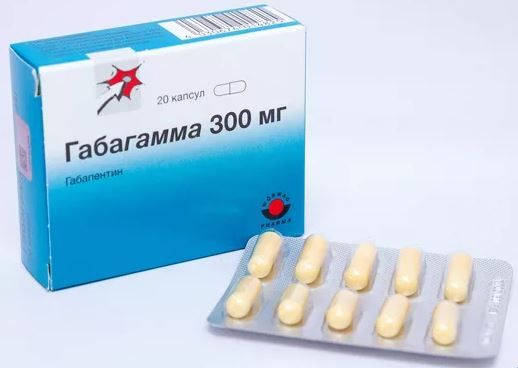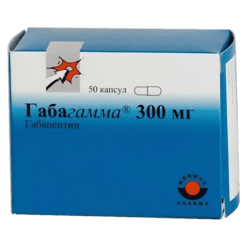No products in the cart.
Gabagamma, 300 mg capsules 20 pcs
€12.63 €11.05
Description
Epilepsy, Seizures
- in complex therapy of partial seizures with or without secondary generalization in adults and children over 12 years old;
- pain syndrome in diabetic neuropathy, postherpetic neuralgia in adults
Indications
Indications
in complex therapy of partial seizures with or without secondary generalization in adults and children over 12 years of age;
pain syndrome in diabetic neuropathy, postherpetic neuralgia in adults
Special instructions
Special instructions
Suicide, suicidal ideation, or clinical deterioration
Suicidal ideation and behavior have been reported in patients receiving antiepileptic drugs for several indications. A meta-analysis of randomized placebo-controlled trials of antiepileptic drugs also showed a small increase in the risk of suicidal ideation and behavior. The mechanism of this risk is unknown, and available data do not exclude the possibility of an increased risk with gabapentin use.
Patients should be closely monitored to identify suicidal thoughts and behavior. When these signs appear, appropriate treatment must be prescribed. Patients and caregivers should be advised to seek medical attention if signs of suicidal thoughts or behavior occur.
Drug rash with eosinophilia and systemic manifestations (DRESS syndrome)
Severe, life-threatening systemic hypersensitivity reactions, such as drug rash with eosinophilia and systemic symptoms (DRESS syndrome), have been reported in patients taking antiepileptic drugs, including gabapentin.
It should be noted that early manifestations of hypersensitivity, such as fever or swollen lymph nodes (lymphadenopathy), may occur even if there is no rash. If such signs or symptoms occur, the patient should be evaluated immediately. Gabapentin should be discontinued unless an alternative cause for these symptoms can be identified.
If a patient undergoing treatment with gabapentin develops acute pancreatitis, treatment with gabapentin should be discontinued.
Although withdrawal syndrome has not been observed with gabapentin treatment, it is not recommended to abruptly stop treatment. Withdrawal of any anticonvulsants in patients with epilepsy can provoke status epilepticus.
When treated with gabapentin, as with other anticonvulsants, some patients may experience an increase in the frequency of seizures or the appearance of new types of seizures. Monotherapy with gabapentin in the treatment of patients
resistant to therapy with anticonvulsants, is not successful, as with the use of other antiepileptic drugs.
Gabapentin is not effective for primary generalized seizures, such as absence seizures, and may worsen these seizures in some patients. Gabapentin should be used with caution in patients with mixed seizures, incl. with absence epilepsy.
Patients 65 years and older
No systematic studies have been conducted with gabapentin in patients 65 years of age and older. In a double-blind study, patients with neuropathic pain aged 65 years and older were shown to have drowsiness, peripheral edema, and asthenia at a slightly higher percentage than younger individuals. Along with these observations, clinical studies in this age group do not indicate that the adverse event profile differs from that observed in younger patients.
Children 12 years and older
The effects of long-term (more than 36 weeks) gabapentin therapy on learning, intelligence, and development in children and adolescents have not been well studied. Therefore, the benefits of long-term therapy must be weighed against the potential risks of such treatment.
Laboratory indicators
Semi-quantitative determination of total protein in urine using test strips may result in false-positive results. In this case, it is recommended to confirm the positive result with other analytical methods, such as the Buret method, turbidimetric or dye binding method, or use alternative methods from the outset.
Gabagamma® contains lactose. The drug is contraindicated in patients with hereditary galactose intolerance, lactase deficiency or glucose-galactose malabsorption.
Impact on the ability to drive vehicles and machinery
Gabapentin may have a slight or moderate effect on the ability to drive and use machines. The drug acts on the central nervous system and may cause drowsiness, dizziness and other symptoms. If these adverse effects are even mild, they can be potentially dangerous when driving vehicles or operating machinery. Symptoms may appear more frequently at the beginning of treatment and as the dose increases.
Active ingredient
Active ingredient
Gabapentin
Composition
Composition
Hard gelatin capsules, No. 1, yellow; The contents of the capsules are white powder.
1 caps.
gabapentin
300 mg
Excipients:
lactose,
corn starch,
talc,
gelatin,
titanium dioxide,
iron oxide yellow,
iron oxide red.
10 pcs. – blisters (5) – cardboard packs.
Contraindications
Contraindications
acute pancreatitis;
hereditary galactase deficiency;
lactase deficiency;
glucose-galactose malabsorption syndrome;
hypersensitivity to any of the components of the drug.
With caution: renal failure, psychotic illness.
Side Effects
Side Effects
The frequency of adverse reactions observed during clinical trials conducted in patients suffering from epilepsy (in combination therapy and with gabapentin monotherapy) and in patients with neuropathic pain is distributed in the following order: very often (more than 10% of cases), often (1%-10% of cases), uncommon (0.1%-1% of cases), rarely (0.01%-0.1% of cases), very rare (less than 0.01% of cases, including reports of isolated side effects). Where different frequencies of side effects were noted, the highest frequency is indicated. The frequency of adverse reactions noted in post-marketing observations cannot be estimated based on available data. In the data below their frequency is listed as “unknown”. Within each group, adverse effects are presented in descending order of severity.
Infections and parasitic diseases: very often – viral diseases; often – pneumonia, respiratory diseases, urinary tract infections, infectious diseases, otitis media.
From the hematopoietic system: often – leukopenia; unknown – thrombocytopenia.
From the immune system: rarely – allergic reactions (including urticarial rash); unknown – drug rash with eosinophilia and systemic symptoms (DRESS syndrome).
Metabolism and nutrition: often – anorexia, increased appetite.
From the mental side: often – hostility, confusion and emotional lability, depression, anxiety, increased nervous excitability, thinking disorders; unknown – hallucinations.
From the nervous system: very often – drowsiness, dizziness, ataxia; often – convulsions, hyperkinesis, dysarthria, amnesia, tremor, sensory disturbances such as paresthesia, decreased sensitivity, impaired coordination of movements, nystagmus, increased, decreased or absent reflexes; rarely – hypokinesia; unknown – other motor dysfunctions (including dyskinesia, dystonia).
On the part of the organ of vision: often – visual disturbances, such as decreased visual acuity, double vision.
From the organ of hearing and labyrinthine disorders: often – dizziness; unknown – ringing in the ears.
From the cardiovascular system: often – arterial hypertension, vasodilation; rarely – palpitations.
From the respiratory system: often – dyspnea, bronchitis, pharyngitis, cough, rhinitis.
From the digestive system: often – vomiting, nausea, dental abnormalities, gingivitis, diarrhea, abdominal pain, dipepsia, constipation, dry mouth and throat, flatulence; unknown – pancreatitis, hepatitis, jaundice.
From the skin and subcutaneous tissues: often – swelling of the face, hemorrhagic rash most often described as bruises as a result of physical trauma, rash, itching, acne; unknown – Stevens-Johnson syndrome, angioedema, erythema multiforme, alopecia.
From the musculoskeletal system and connective tissue: often – joint pain, muscle pain, back pain, convulsive twitching; unknown – myoclonus.
From the kidneys and urinary tract: unknown – acute renal failure, urinary incontinence.
From the genital organs and mammary gland: often – impotence; unknown – breast hypertrophy, gynecomastia.
General disorders and disorders at the injection site: very often – fatigue, fever; often – peripheral edema, gait disturbances, asthenia, pain, malaise, flu-like syndrome; rarely – generalized edema; unknown – withdrawal syndrome (mainly anxiety, insomnia, nausea, pain, sweating), chest pain. Cases of sudden unexpected death have been reported where a causal relationship to gabapetpin treatment has not been established.
From laboratory and instrumental studies: often – leukopenia, weight gain; rarely – increased levels of liver enzymes (AST, ALT) and bilirubin; unknown – fluctuations in blood glucose levels in patients with diabetes.
Injuries, intoxications and complications of manipulations: often – accidental injury, fracture, abrasions.
There have been reports of cases of acute pancreatitis during treatment with gabapentin. A cause-and-effect relationship with gabapentin has not been established.
Cases of myopathy with elevated creatine kinase levels have been reported in patients with end-stage renal disease undergoing hemodialysis.
Respiratory tract infections, otitis media, bronchitis and convulsions in children have only been reported in clinical studies. In addition, in clinical studies in children, aggressive behavior and hyperkinesis were observed in most cases.
Interaction
Interaction
A study in healthy volunteers (n=12) showed that when co-administered with morphine controlled-release capsules 20 mg/capsule. 2 hours before taking gabapentin, there was an increase in the mean AUC of gabapentin by 44% compared to this value without taking morphine. Patients taking morphine and gabapentin together should be closely monitored due to the risk of developing symptoms of CNS depression (drowsiness). If such symptoms occur, the dose of gabapentin or morphine should be reduced.
No interactions were observed between gabapentin and phenobarbital, phenytoin, valproic acid, or carbamazepine. The steady-state pharmacokinetics of gabapentin are similar for healthy subjects and patients with epilepsy receiving other anticonvulsants.
Concomitant use of gabapentin and oral contraceptives containing norethindrone and/or ethinyl estradiol does not affect the pharmacokinetics of either component.
With simultaneous use of gabapentin with antacids containing aluminum and magnesium, the bioavailability of gabapentin is reduced by 24%. It is recommended to take gabapentin approximately 2 hours after taking antacids.
When taking probenecid, the renal excretion of gabapentin does not change.
When taken together with cimetidine, a slight decrease in the renal excretion of gabapentin is observed, which has no clinical significance.
Overdose
Overdose
Symptoms: dizziness, diplopia, speech impairment, drowsiness, lethargy, diarrhea and increased severity of other side effects.
Treatment: gastric lavage, taking activated carbon, symptomatic therapy. Hemodialysis may be indicated for patients with severe renal failure.
Storage conditions
Storage conditions
The drug should be stored out of the reach of children at a temperature not exceeding 25°C.
Shelf life
Shelf life
3 years
Manufacturer
Manufacturer
Dragenopharm Apotheker Püschl GmbH, Germany
Additional information
| Shelf life | 3 years |
|---|---|
| Conditions of storage | The drug should be kept out of reach of children at a temperature not exceeding 25 ° C. |
| Manufacturer | Artesan Pharma GmbH & Co. KG, Germany |
| Medication form | capsules |
| Brand | Artesan Pharma GmbH & Co. KG |
Other forms…
Related products
Buy Gabagamma, 300 mg capsules 20 pcs with delivery to USA, UK, Europe and over 120 other countries.














